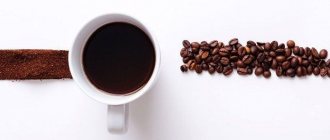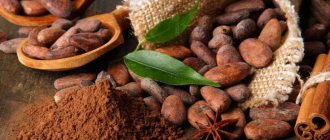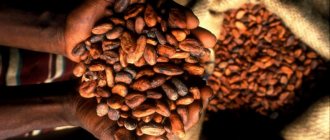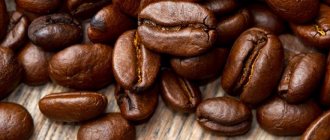What is cocoa made from?
Chocolate tree
A drink called “cocoa” is made from cocoa beans. These same fruits are the main ingredient in creating chocolate.
Cocoa beans grow on trees of the mallow family. This evergreen tree is called Theobroma.
In our country it is customary to simply call it a chocolate tree. The chocolate tree is native to the subequatorial regions of South America.
The cocoa tree is also found in its wild natural form in Mexico and Central America. The plant can reach 12 meters in height.
The fruits of the chocolate tree ripen not on the branches, but directly on the trunk. They are shaped like a huge lemon or melon.
Fruit ripening time is 4 months. Each fruit contains from 20 to 60 seeds - cocoa beans.
The chocolate tree is grown in subequatorial countries. Blooms and bears fruit all year round.
The leading countries producing cocoa beans are: Cod-Divoire, Indonesia, Ghana, Nigeria, Cameroon, Brazil, Ecuador and Togo.
Other cocoa-growing countries include Papua New Guinea, the Dominican Republic, Colombia, Peru, Mexico, Venezuela and Malaysia.
Caffeine - benefits and toxicity
Is there any benefit to caffeine? Positive characteristics:
- Increased physical and intellectual performance, motor activity;
- Temporary reduction in drowsiness and fatigue;
- Increased and deepening of breathing, which expands the bronchi;
- Reducing the risk of atherosclerosis and cardiovascular diseases;
- Reducing the risk of diabetes;
- Improving metabolic processes and metabolism;
- Increased secretory activity of the stomach.
Coffee and tea, when consumed in moderation, bring only benefits. How much caffeine can you consume? The norm is 250 mg of caffeine once a day (5 cups of drinks).
The toxicity of caffeine is reflected in its excess consumption. It can lead to the following consequences:
- Increased anxiety;
- State of depression;
- Insomnia;
- More frequent urination;
- Caffeine addiction;
- Increased excitability;
- Reduced absorption of calcium by the body.
It is necessary to pay special attention to how much caffeine your child consumes per day. Children with hyperactivity should especially limit their use. Also during pregnancy it is advised to give up coffee drinks.
Useful properties of cocoa
Cocoa beans properties
About 300 different substances have been found in cocoa beans.
It is this fact that makes this product unique and very useful for the human body.
Cocoa contains a rich vitamin and mineral complex, vegetable protein, unsaturated fatty acids and other components.
This is a very high-calorie product. 100 grams of cocoa can contain from 200 to 400 kcal. It perfectly saturates the body and charges it with energy for the whole day.
However, for those who want to lose weight, it is better to limit the number of cups of this delicious drink you drink.
Cocoa is very beneficial for blood vessels. It is rich in bioactive components that prevent platelet aggregation.
The antioxidant properties of cocoa are unique; they are more effective than even orange juice, apples and tea.
Cocoa can stimulate the production of endorphins in the body - hormones of joy.
Cocoa promotes rapid restoration of muscle tissue, has a beneficial effect on the skin, and also reduces the risk of diabetes, cancer, stomach ulcers, stroke and heart disease.
Rejuvenation and wound healing
Not only the drink, but also cocoa masks bring significant benefits to the body. Cocophilus, niacin, vitamins PP, B5 and B9 present in cocoa help improve the regeneration of skin cells, thereby speeding up wound healing processes, relieving irritation, smoothing out wrinkles, evening out complexion and skin structure. The presence of iron allows oxygen access to the upper layers of the epidermis. Potassium allows you to retain water in the cells, preventing dry skin. Cocoa restores the protective functions of the skin and stimulates the production of collagen and elastin.
Harmful properties of cocoa
Cocoa beneficial and harmful properties
Despite the huge list of miraculous properties, drinking this drink can be fraught with serious danger.
But it lies not in the properties of cocoa beans, but in their quality and methods of cultivation and processing.
The fact is that when industrially growing this product, careless producers often use large amounts of pesticides and chemical fertilizers.
Cocoa is the world's leading crop in terms of the amount of pesticide treatment.
Another danger lies in the poor sanitary conditions of most cocoa-growing countries.
Therefore, when choosing a product, pay attention to its quality.
Visually, cocoa powder should have a brown color without any impurities or inclusions. When rubbed between your fingers, no lumps should form.
Natural cocoa must contain at least 15% fat. It should not leave sediment when preparing the drink.
Also, when buying cocoa, pay attention to the country of origin. Do not buy a drink produced in countries where the chocolate tree does not grow.
Reduced pressure
Drinking 2 cups of the drink serves as a good prevention of heart attack and reduces weather dependence, due to the presence of flavonoids. The level of high-density lipoproteins decreases, as a result of which platelets do not stick together, and the risk of thrombosis is minimized. The presence of theobromine increases the resistance of the heart muscle to pressure surges.
Does cocoa have caffeine?
Is there caffeine in cocoa powder?
To the question of whether there is caffeine in cocoa, there is only one answer - yes, there is!
But its amount is relatively small, on average it is 0.2%.
And since the attitude towards caffeine is currently ambiguous: some categorically claim that it is harmful, others have the opposite opinion, you will have to decide whether this drink is suitable for you yourself.
However, the very fact of its presence in this drink should make people for whom caffeine poses a potential danger be more careful when using cocoa.
Do not rush to give up your favorite drink just because you discovered the presence of caffeine in it.
It’s better to study in detail the properties of this controversial component, and then be sure to compare its content in different products.
The invigorating effect of “brown gold”
A cup of sweet cocoa in the morning invigorates no less than a serving of latte or cappuccino. Theobromine, flavanol and, of course, caffeine provide a tonic effect. The content of the latter, to the delight of fans of the drink, is quite low.
Caffeine in the product
Beans of different geographic origins and varieties may have different concentrations of this substance.
- This is interesting: Where and how cocoa beans grow
On average, 200 ml of natural, properly brewed cocoa contains 10-15 mg of caffeine. For comparison, in the same cup of bean coffee there is hidden from 100 to 200 mg of the substance, and in instant coffee there is 50-100 mg of the substance. By the way, some types of “fast” coffee contain even more alkaloid than natural coffee.
The lowest content of natural stimulant is in granular (soluble) powder. The reason for this is the minimum concentration of beans in the product. For example, the caffeine content in Nesquik cocoa is negligible. But the beneficial properties of real powder, accordingly, are absent.
- Don't miss: Benefits of cocoa powder for the human body
Soluble granules and any product whose fat content is less than 15% should not be purchased. This means that the powder contains foreign mixtures and there is nothing healing.
What you need to know
Don't be overly concerned about caffeine. It is found in chocolate, tea, Coca-Cola, energy drinks and more. Today, scientists have an ambiguous view of this alkaloid: both harm and beneficial properties are attributed to it. It turns out that this substance stimulates physical and brain activity; improves respiratory processes; promotes good metabolism; is the prevention of cardiovascular diseases.
The main rule is to consume any caffeine-containing products in moderation. This also applies to cocoa. Two cups is the optimal daily intake for an adult. And it is advisable to drink these portions in the first half of the day.
There is an opinion that you can drink cocoa at night and sleep peacefully. Let's say everything is individual. An evening cup of aromatic drink is quite capable of disrupting healthy sleep.
Contraindications
It is not recommended to drink chocolate drink for children under three years of age. From 3 to 6 years old, a child can be given no more than 50 ml per day, no more than 4 times a week. Once children reach 6 years of age, they can enjoy delicious and healthy cocoa every day.
If a child is prone to allergies, the drink should be drunk with caution. It is not caffeine that can cause an undesirable reaction, but natural aromatic compounds in the beans. The nutritional powder is also contraindicated for people diagnosed with cirrhosis of the liver. And, of course, no one canceled the individual intolerance to the product.
The effect of cocoa on the body
Cocoa harms and benefits effects on the human body
When caffeine enters the human body, it stimulates the central nervous system, accelerates the pulse, dilates blood vessels, and makes the heart work more actively. Based on these properties, it is widely used in medicine.
Caffeine is part of painkillers; it is used to stimulate the respiratory and cardiac organs, and is prescribed when it is necessary to increase mental or physical activity.
As you can see, caffeine has benefits for a certain category of people. Therefore, everyone should not give up cocoa because of the content of this element.
It is fraught with danger only for people with increased excitability, insomnia, certain heart diseases, glaucoma, the elderly, and for patients with polycystic disease.
In all other cases, moderate consumption of caffeine-containing foods is not dangerous.
Caffeine content in chocolate
Does chocolate have caffeine? Chocolate is a product of the cocoa tree, so it also contains caffeine. The effect of caffeine on raising energy and good mood is not very significant, because in addition to it it contains other stimulants.
Sugar increases vitality; chocolate also contains tryptophan, phenethylamine and theobromine. Phenethylamine has a minor effect on the body, tryptophan has a calming effect.
Caffeine is credited with many of the properties that theobromine actually has. For example, it can cause poisoning in animals, which is why cats and dogs do not like chocolate. There is very little caffeine in chocolate itself, so it has virtually no effect on people. The body's reaction occurs mainly to theobromine.
The amount of caffeine in chocolate also depends on its type - the higher the percentage of cocoa in it, the more caffeine.
Caffeine addiction
Excessive coffee consumption can lead to caffeine addiction. Its symptoms:
- Anxiety,
- Irritability,
- Tachycardia,
- stomach disorders,
- Facial redness,
- More frequent urination.
In the most advanced cases, caffeine addiction can manifest itself in confusion of speech and consciousness, photophobia, and tremors of the limbs. When intoxication is repeated once a day, the body adapts to a new regime. The main positive property of caffeine is lost - a feeling of vigor. A person still drinks coffee, because without it he is unable to do even ordinary things. A person addicted to caffeine actively feels weak and depressed. A powerful pain in the head in the middle of the forehead is also added.
Getting rid of caffeine addiction is quite easy - the bad symptoms when giving up caffeine-containing products disappear in a maximum of a week. In the first days, you need to realize that there will be a loss of strength, pain in the head, and excessive drowsiness.
After eliminating the negative signs, it is necessary to limit the consumption of coffee, preferably to one cup per day. Any type of addiction may indicate the presence of mental problems, so it is worth visiting a psychologist.











